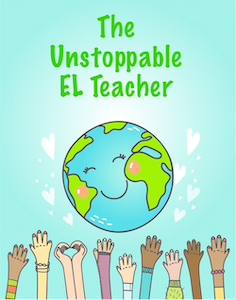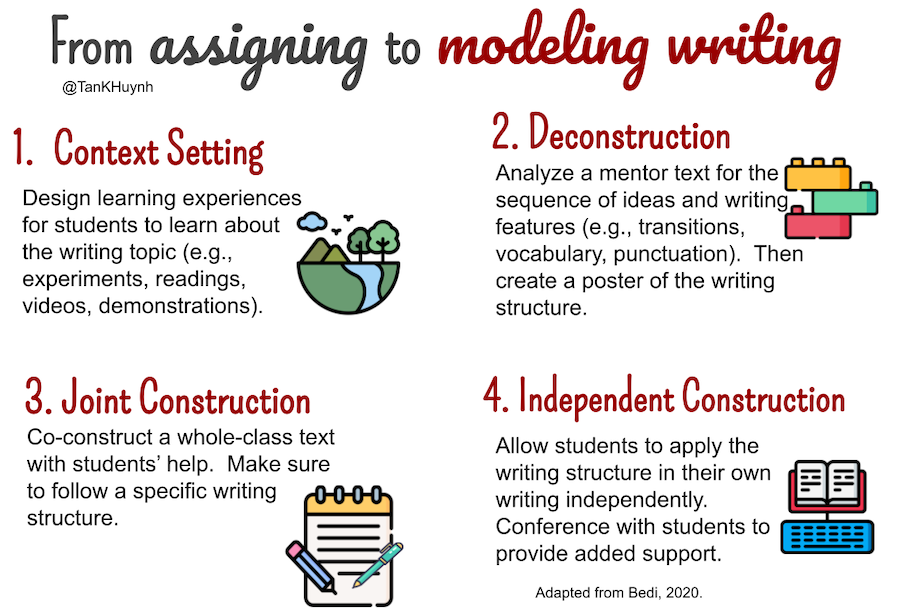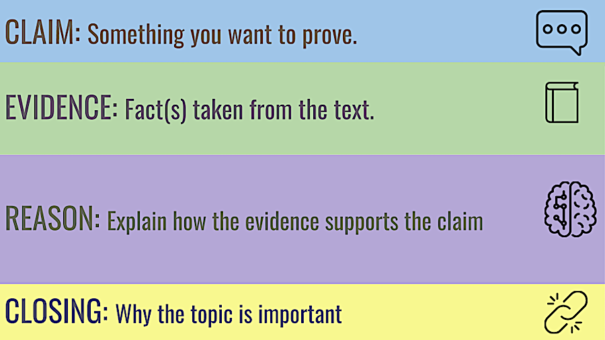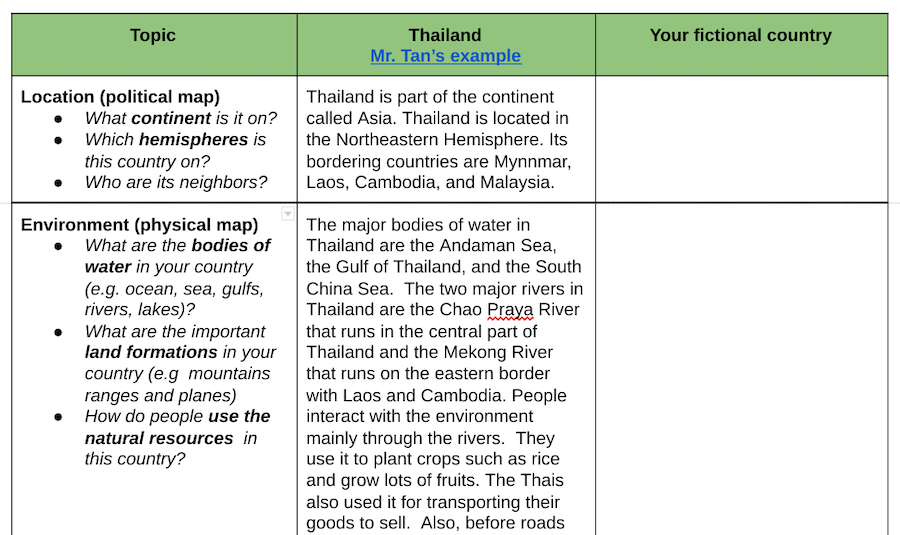Scaffolding Writing for Language Learners
A MiddleWeb Blog

I knew it was important and essential for me to teach, but I was overwhelmed by the task. Where does one start? Brainstorming, outlining, grammar, organizing paragraphs? It felt like too much!
Fortunately, there are models of writing instruction available to teachers, and one of them, the Teaching and Learning Cycle, comes from Australia. It’s part of their program called Teaching ESL Students in the Mainstream Classroom.
This MiddleWeb article, based on a podcast conversation with consultant and workshop facilitator, Indu Bedi, will walk you through the process of making writing visible to students.
Context setting
Long before students begin to write, we are setting the context. This means we are providing students with opportunities to learn content and form understandings about the topic. Teachers can set the context by having students talk, read, view videos, and engage in simulations about a particular topic.
Jumping into writing without any background knowledge of the topic is a scary prospect for adults, let alone language learners. But when we plan our steps and prepare our students with just a little bit of pre-knowledge, they become more confident in learning the next step in the process: deconstruction.
Deconstruction

Indu Bedi is Deputy Headmaster at the Headstart International School (Thailand)
At this point we provide students with a mentor text as a model. Guide students in talking about the purpose of this text (e.g., to persuade, narrate, explain, or inform). This direction is key, Indu Bedi says, as we are explaining to students that every piece of writing has a purpose, and the purpose informs how we write.
In a secondary context, the mentor text might be a single, well-crafted paragraph with ideas sequenced in a particular order. The paragraph can contain things such as:
- a topic sentence
- sentences that provide evidence
- content-specific information
- sentences that analyze the evidence
- sentences that conclude the paragraph
- transition phrases
In the elementary grades, it might just be a sentence. That sentence should contain particular things we are trying to have students learn, such as:
- capitalization
- particular punctuation marks
- adjectives and adverbs
- prepositions
- content-specific nouns
- Tier 2 transferable verbs (e.g., expand, increase, decrease, effect)
In this phase of writing, the teacher is the expert and is guiding students through understanding the role of each sentence and why it is sequenced where it is in the paragraph. This instruction will form students’ understanding of the writing genre.
I recommend that you reformat the sequencing of the ideas into a visual and either place it on the wall or give it to students as a graphic. You and the students can refer to the visual in the next phase, Joint Construction.
For example, my 5th-grade team decided to use the CERC format for expository writing. I created the graphic below and printed it onto large posters, which were then hung on the wall of each of the 5th-grade classes.
You can also use technology to visualize the breakdown of your mentor text. Using color-coded highlighting on a Google Doc can help students easily differentiate between, for example, the parts of writing that are analysis versus claims or evidence.
Joint Construction
If students are unfamiliar with the genre of writing currently in focus, co-construct the writing with them using the visual that you created for students during the Modeling and Deconstruction phase above. Guide students in writing a class-produced text that follows the writing structure from the visual/poster.
Make sure to: follow the sequence of the writing structure, model using specific transitions, incorporate content-specific nouns and verbs, and point out particular punctuation marks and grammatical features.
For example, my 5th grade co-teacher and I wanted to construct with students a research report on a global issue. We picked Zimbabwe’s food insecurity. We would watch a video together or read a short article on food insecurity in Zimbabwe. This background information established the students’ content-specific knowledge on this topic.
We then used the writing outline that the teacher and I had already created for students and showed it to them during the Modeling and Deconstruction phase. We started off with the introduction paragraph.
For each sentence of the introduction paragraph, we would ask them for ideas. The co-teacher and I would then write that idea on a Google Doc and project it on the screen. We repeated this process for each of the subsequent paragraphs for the research report.
The key to Joint Construction is teachers demonstrating the thinking of how to turn ideas into writing. The common phrases we used are:
- What does a [topic sentence] have to do again?
- How would we write [the topic sentence]?
- What punctuation would work here?
- What transition can we use here?
When we verbalize our thought processes, we’re pointing out the linguistic and structural decisions authors make when writing. It makes writing instruction scaffolded, explicit, and less of a mystery.
As an added scaffold, you can choose to have students work in pairs to co-construct a piece of writing after the whole-class joint construction of the shared text you just modeled. Make sure that students refer to the writing structure visual as they write. I also suggest providing students with a content-specific word bank that they must use in their co-constructed paragraph.
Independent Construction
By this point students have at least two reference points (possibly four) to write their own piece of text. Before they start writing, have students plan their ideas out following the writing structure. Use this to conference with students as they write or to provide small-group instruction for students who will benefit from the extra support.
One additional support is to create a document that contains both the writing structure and a space for students to write their ideas. In the example below, I used a document that identifies the theme (geography) I wanted students to write about, the details students were to address in each theme, a mentor text created by me, and a space for their writing.
Conclusion
Writing instruction can be challenging because there are so many elements at play. We can make writing a less complex, less daunting experience by creating a context for writing, deconstructing a mentor text, co-constructing writing, and scaffolding students’ writing while they work independently.
This process provides multiple entry points to writing long before students actually write anything down. They begin more naturally by analyzing pieces of writing and talking about the writing structure. Students then progress to collaborating with each other and you to create a whole-class text.
With these supports your students will be more confident and ready to produce text independently. More importantly, you now have a process to lean into something challenging.
Indu has been so generous in providing slides that go along with this article. You can access the slides here.
What part of Indu’s process have you already been doing, and which part of the process will you add to your writing instruction?






































